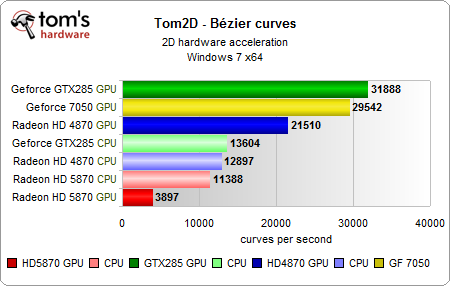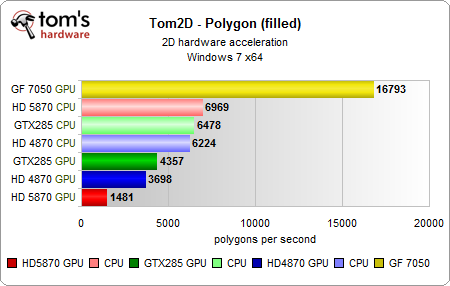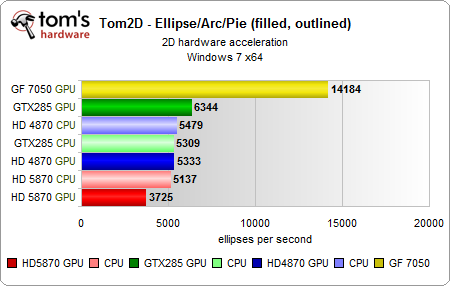2D, Acceleration, And Windows: Aren't All Graphics Cards Equal?
Tom2D Benchmark Results, Continued
Test 3: Bezier Curves
This test paints the same picture as our line drawing test. The Radeon HD 5870 brings up the rear, reaffirming our suspicion that it isn't able to correctly handle 2D applications. This is completely intolerable, even for consumers.
With Aero graphics turned on and DWM activated, the GeForce GTX 285 delivers nine times the performance. Likewise, even the old on-board graphics chipset blows past the new ATI card. In comparison, the Radeon HD 4870's performance is quite interesting: it is capable of accelerating curves in hardware, even though its results fall behind those from both Nvidia solutions as well.
Test 4: Rectangles
Because the Radeon HD 5870 has clear issues with rendering lines (especially at heavier stroke weights), we saw that half of the results for our rectangle tests echo those observations, without any surprises.
Nevertheless, it’s quite interesting that performance doubles for the Radeon HD 5870 when hardware acceleration is turned on, versus when it’s turned off, even if performance still falls behind the GeForce 7050 GPU.
This rectangle test was the only one where we detected a measurable effect indicating hardware acceleration on the ATI cards, and where it merited such a designation. The Radeon HD 4870 benefited more from this effect than the 5870, even if it trailed the pack with acceleration turned off on this particular metric.
Get Tom's Hardware's best news and in-depth reviews, straight to your inbox.
Test 5: Polygons
In this case, the win goes to the older on-board graphics chipset. Nvidia's nForce 610i bested all of the discrete boards by a surprisingly wide margin, both with 2D acceleration enabled and disabled. It was interesting to observe that, for both of the top 3D cards, polygon acceleration didn’t work at all.
The on-board chip, with Aero enabled, runs 10 times faster than the Radeon HD 5870. Without acceleration, the Radeon HD 4870 runs just a tad slower than the 5870. But with Aero turned on, it runs nearly twice as fast.
Test 6: Circles, Arcs, and Ellipses
These results are similar to what we saw above. Both of the high-end cards offer essentially no 2D acceleration, while the on-board graphics chipset scores again. The Radeon HD 5870 falls to the bottom of the pack here, while the older Radeon HD 4870 is somewhere in the middle.
Note
We observed similar results, overall, when we used a Radeon HD 5750, which rules out some defect specific to the 5870. We also compared Catalyst 9.11 and 9.12, noticing a measurable performance increase from the older to the newer version, regardless of whether hardware acceleration was turned on or off. Our next exercise was to compare Windows 7 to Vista, but we don’t want to give away too much of part two. Suffice it to say that even here, we found a few surprises as we worked our way through those tests.
Current page: Tom2D Benchmark Results, Continued
Prev Page Tom2D Benchmark: Radeon HD 5870 Vs. GeForce GTX 285 In Windows 7 Next Page Tom2D Conclusions, Preview Of Part 2Tom's Hardware is the leading destination for hardcore computer enthusiasts. We cover everything from processors to 3D printers, single-board computers, SSDs and high-end gaming rigs, empowering readers to make the most of the tech they love, keep up on the latest developments and buy the right gear. Our staff has more than 100 years of combined experience covering news, solving tech problems and reviewing components and systems.
-
pcxt21 Very nice work! Until that little update I was ready to put my old Matrox Millennium (1996/1997 I think) 2d accelerator back into my gaming rig...Reply -
For those who still remember Matrox...shouldn't that be included in the test as well? Ancient history shows that it was the best card to be paired with VooDoo when first released...:PReply
-
one-shot LOL. The clip of Steve Ballmer looks like an ad from the late Billy Mays. To think he's the CEO of Microsoft after watching that clip makes me laugh. I'm going to watch it again.Reply -
chookman I actually went to put a Professional Matrox card (G550 PCI-e) in my Windows 7 machinde for a few more displays... alas it seems most of the range doesnt have Windows 7 drivers yet :(Reply -
Belardo The sad thing is, as shown was that Windows 1.0~3.0 were never an operating system, ever. 1.0~2.x we're never really used by anyone, yet Amigas and Macs had full GUI functionality since 85/84... Windows3 was at least usable, but still a single-tasking POS, and yet MS-DOS was able to dominate the computer industry... not because of talent, but because of luck, good moves by Gates & Ballmer and the stupidity of IBM. It kind of worked out anyway thou.Reply
Think about it, it wasn't until the tail-end of 1995, with the release of Windows95, did MS produce an actual GUI OS for the general public, 10 whole years after Apple's Mac and the Amiga by chicken lips. Atari only copied much of the hardware abilities of Amiga with a variant of a MS-DOS clone.
Only business bought PC-Clones in the 80s~90s, paying around $1500~4000 per desktop. Since IBM didn't make the OS and the hardware was generic, it was super easy for clones to exists. Home users bought Amigas and Macs and laughed as DOS users... but in the end, they lost to the clones.
At one time in 1990, the Computer Shopper Mag was about 500 pages (phone book) with at least 500 Clone companies advertising.
Windows is still the Copy-Cat OS. Its still an ugly beast under the hood. At least Windows7 runs good and looks nice.
-
Raid3r Indeed, way to take one for the team..I am one of those 2d workers and greatly appreciate the foot that was used to affirm the position of 2d recognition on these "new" cards. I can't say it enough.Reply -
micky_lund woot for toms...Reply
catch some more massive companies out, and make them fix up their drivers -
Belardo I just finished reading this entire article. A good one too guys.Reply
While I had my rant about old MS days, I did work in the PC field starting with 3.1. We'd benchmark various video cards with programs that would test lines, boxes, etc. This WAS important for some games like DOOM and Quake which were not "true" 3D cards we have today.
For every new type of PC build or a clients computer, I would save these generic overall system benchmarks. And I *have* notice different 2D performance abilities of computers and the various cards. All super fast compared to the 90s, but I've seen a GF card perform worse than an older ATI, but also an older ATI work a bit better than a newer one. These are all WinXP and don't have anything to do with the problems of Win7 and/or DX11... Part2 isn't out yet... but I would be curious to see if the problems in Win7 happens in Vista with DX11 installed hmmm.
ATI has been putting all their work into 3D gaming performance, its good to see that they have put a team to fix their 2D issues. There is a good chance that this is a DX11 issue they were not aware of. Since Nvidia doesn't have any DX11 parts (but a DX10.5) - this "bug" doesn't yet show... but I'm speculating of course. :)
With the eye-candy of Win7, the 2D performance *IS* important for those doing work, watching videos, etc. No good excuse to miss this, and hopefully ATI will have it resolved in 1-2 months.
PS: Your memory usage chart of vista vs Win7 shows exactly WHY Vist . That is why Windows7 runs pretty good on a 1GB computer, but Vista still needs at least 3GB for a bottom-end PC. My notebook has Win7rc with 1GB, runs fine.
Hey, will your results sometime include intel graphics? After this bug-issue is resolves, include overall-2D scores with your graphics Charts. :)




